The GASCAP model was developed to provide a software tool for analysis of the life-cycle GHG emissions associated with the construction and maintenance of transportation projects. This phase of development included techniques for estimating emissions from induced travel when a project involves a capacity expansion; a life-cycle maintenance module based on recommended procedures for maintaining a road surface over 50 years; an automated method for inputting construction equipment activity associated with selected project types; a method based on the Highway Capacity Manual for estimating emissions associated with project staging and the diversion of traffic around a worksite; methods for more easily updating emissions factors in the model; and, a variety of miscellaneous upgrades to account for SF6 emissions, upstream electricity emissions associated with asphalt, and incorporation of additional bid-sheet codes in the materials module. Four case studies to demonstrate the models usage were also conducted. These were: a large project case study (reconstruction of rt 35 in Ocean County) that demonstrated the full capabilities of the model; a smaller project (rt 47 resurfacing in Gloucester County) that focused on different staging options and the impact on emissions from traffic; an applied case study conducted in collaboration with NJDOT staff in the South Jersey regional office that focused on maintenance activities; and a demonstration of the relationship between the embodied fuel cost of a project and the GHG emissions. The software and related documentation is available for use on www.gascap.org and users are requested to upload any analysis results to provide information for further development of the software.




